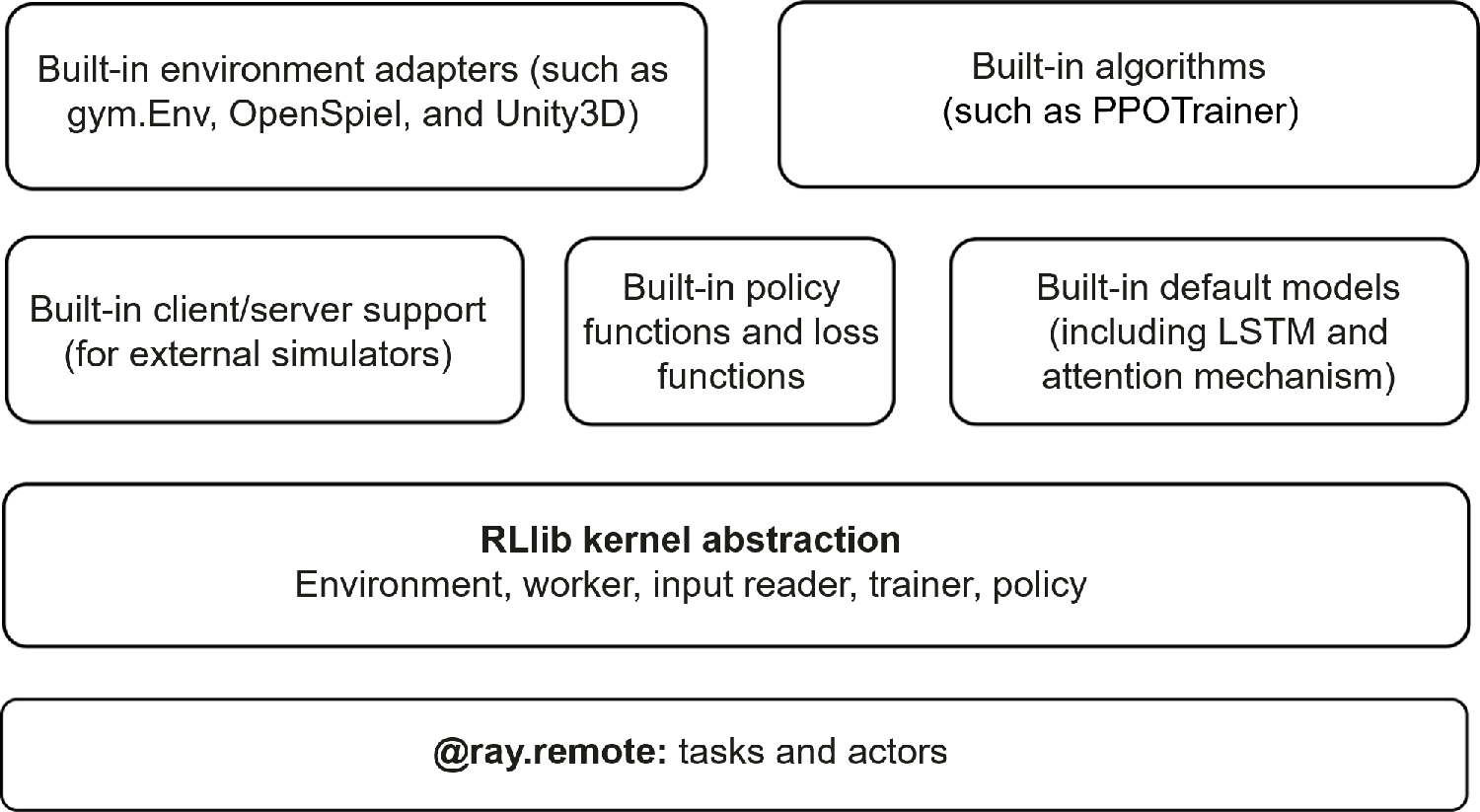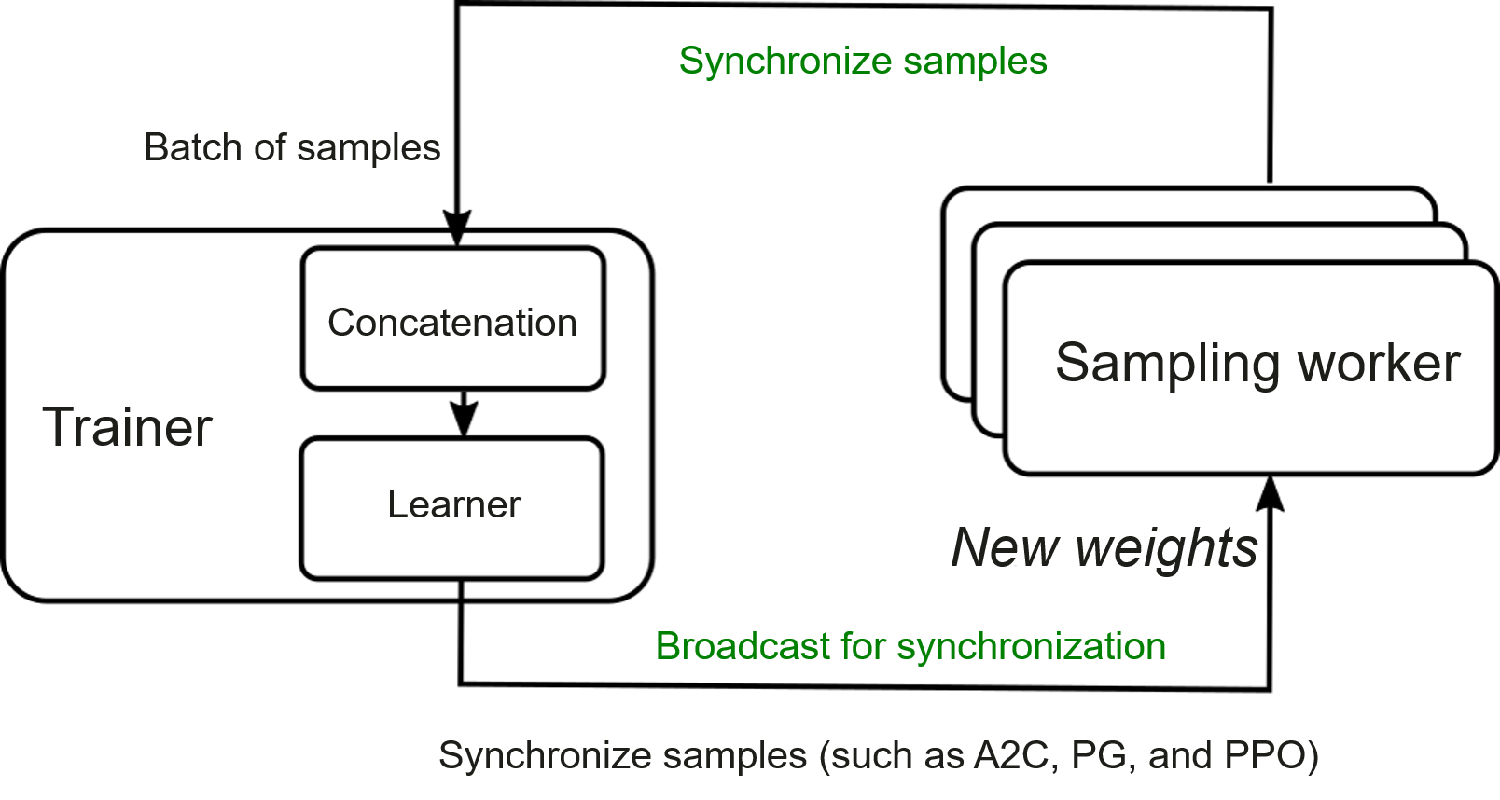12.4. Distributed Reinforcement Learning System¶
The distributed reinforcement learning system is more powerful than the single-node reinforcement system we discussed earlier. It features parallel processing capability of multiple models in multiple environments, meaning it can update multiple models on multiple computer systems at the same time. As such, it significantly accelerates the learning process and improves the overall performance of the reinforcement learning system. This section focuses on common algorithms and systems in distributed reinforcement learning.
12.4.1. Distributed RL Algorithm–A3C¶
Asynchronous Advantage Actor-Critic (A3C) was proposed by DeepMind researchers in 2016. This algorithm can update networks on multiple computing devices in parallel. Unlike the single-node reinforcement learning system, A3C creates a group of workers, allocates the workers to different computing devices, and creates an interactive environment for each worker to implement parallel sampling and model update. In addition, it uses a master node to update actor networks (policy networks) and critic networks (value networks). These two types of networks correspond to the policy and value functions in reinforcement learning, respectively. Such a design allows each worker to send the gradients computed based on the collected samples to the master node in real time in order to update the parameters on the master node. The parameters are then transferred in real time to each worker for model synchronization. Each worker can perform the computing on a GPU. In this way, the entire algorithm updates the model in parallel on a GPU cluster. Figure Fig. 12.4.1 depicts the algorithm structure. Research shows that in addition to accelerating model learning, distributed reinforcement learning helps stabilize learning performance. This is because the gradients in distributed reinforcement learning are computed based on environment sampled from multiple nodes.
Fig. 12.4.1 A3C distributed algorithmarchitecture¶
12.4.2. Distributed RL Algorithm–IMPALA¶
Importance Weighted Actor-Learner Architecture (IMPALA) is a reinforcement learning framework proposed by Lasse Espeholt et al. in 2018 to implement clustered multi-machine training. Figure Fig. 12.4.2 depicts this architecture. Like A3C, IMPALA enables gradient computation on multiple GPUs in parallel. In IMPALA, multiple actors and learners are paralleled. Each actor has a policy network to collect samples by interacting with another environment. The collected sample trajectories are sent by actors to their respective learners for gradient computation. Among the learners, there is a master learner. It can communicate with other learners to obtain their computed gradients for the update of its model. After the model is updated, the model is delivered to other learners and actors for a new round of sampling and gradient computation. As a distributed computing architecture, IMPALA is proved to be more efficient than A3C. It benefits from a specially designed gradient computation function in learners and from V-trace target in addition to stabilizing training based on importance weights. Because the V-trace technique is not related to our area of focus here, we will not elaborate on it. Interested readers can learn more from the original paper.
Fig. 12.4.2 IMPALA distributed algorithmarchitecture¶
12.4.3. Other Algorithms¶
Apart from A3C and IMPALA, researchers have proposed other algorithms in recent studies, for example, SEED and Ape-X . These algorithms are more effective in distributed reinforcement learning. Readers can find out more about these algorithms from the corresponding papers. Next, we move on to some typical distributed reinforcement learning algorithm libraries.
12.4.4. Distributed RL System – RLlib¶
RLlib — based on Ray , which is a distributed computing framework initiated by several researchers from UC Berkeley — is built for reinforcement learning. It is an open-source reinforcement learning framework oriented to industrial applications. RLlib contains a reinforcement learning algorithm library and is convenient for users who are not that experienced in reinforcement learning.
Figure Fig. 12.4.3 shows the architecture of RLlib. Its bottom layer is built on Ray’s basic components for distributed computing and communications. Oriented to reinforcement learning, basic components such as Trainer, Environment, and Policy are abstracted at the Python layer. There are built-in implementations for the abstracted components, and users can extend the components based on their algorithm requirements. With these built-in and customized algorithm components, researchers can quickly implement specific reinforcement learning algorithms.

Fig. 12.4.3 RLlibarchitecture¶
RLlib supports distributed reinforcement learning training of different paradigms. Figure Fig. 12.4.4 shows the distributed training architecture of the reinforcement learning algorithm based on synchronous sampling. Each rollout worker is an independent process and interacts with the corresponding environment to collect experience. Multiple rollout workers can interact with the environment in parallel. Trainers are responsible for coordinating rollout workers, policy optimization, and synchronization of updated policies to rollout workers.

Fig. 12.4.4 RLlib distributedtraining¶
Reinforcement learning is usually based on deep neural networks. For distributed learning based on such networks, we can combine RLlib with a deep learning framework such as PyTorch and TensorFlow. Adopting such an approach means that the deep learning framework takes responsibility for training and updating the policy network, with RLlib taking over the computation of the reinforcement learning algorithm. RLlib also supports interaction with paralleled vectorized environments and pluggable simulators, as well as offline reinforcement learning.
12.4.5. Distributed RL System–Reverb and Acme¶
For management of experience replay buffer, Reverb is an inevitable topic. At the beginning of this chapter, we introduced concepts such as state, action, and reward in reinforcement learning. The data used for training in real-world applications comes from the data samples stored in the experience buffer, and the operations performed on the data may vary depending on the data formats. Common data operations include concatenation, truncation, product, transposition, partial product, and mean or extreme value. These operations may be performed on different dimensions of the data, posing a challenge for existing reinforcement learning frameworks. In order to flexibly use data of different formats in reinforcement training, Reverb introduces the concept of chunk. All data used for training is stored as chunks in the buffer for management and scheduling. This design takes advantage of data being multidimensional tensors and makes data usage faster and more flexible. DeepMind recently proposed a distributed reinforcement learning framework called Acme , which is also designed for academia research and industrial applications. It provides a faster distributed reinforcement learning solution based on a distributed sampling structure and Reverb’s sample buffer management. Reverb solves the efficiency problem of data management and transfer, allowing Acme to fully leverage the efficiency made possible in distributed computing. Researchers have used Acme to achieve significant speed gains in many reinforcement learning benchmark tests.
